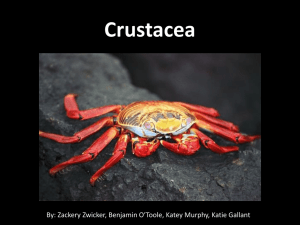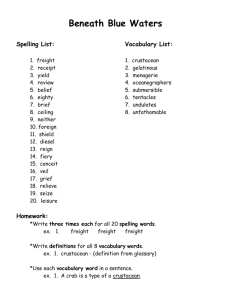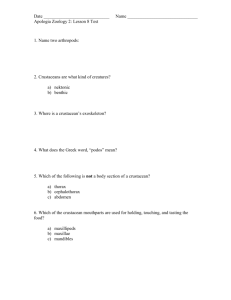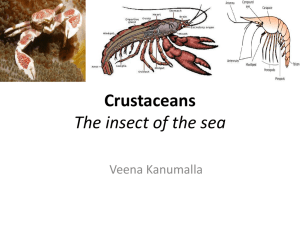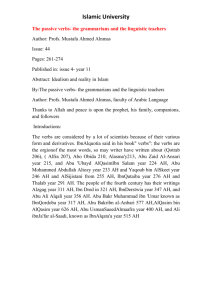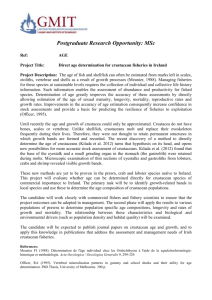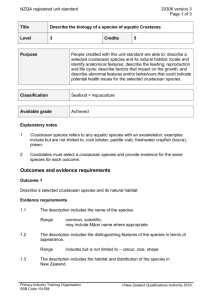INTERNATIONAL JOURNAL OF ENVIRONMENTAL SCIENCE ... ENGINEERING (IJESE) Vol. 6: 21 - 34 (2015)
advertisement
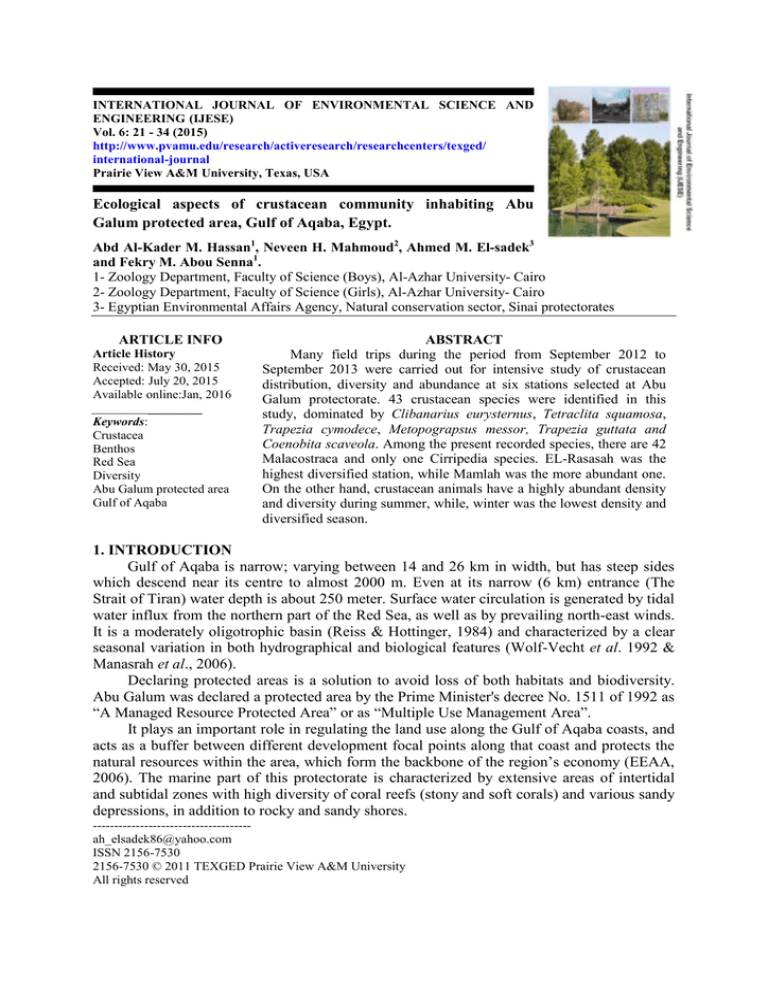
INTERNATIONAL JOURNAL OF ENVIRONMENTAL SCIENCE AND ENGINEERING (IJESE) Vol. 6: 21 - 34 (2015) http://www.pvamu.edu/research/activeresearch/researchcenters/texged/ international-journal Prairie View A&M University, Texas, USA Ecological aspects of crustacean community inhabiting Abu Galum protected area, Gulf of Aqaba, Egypt. Abd Al-Kader M. Hassan1, Neveen H. Mahmoud2, Ahmed M. El-sadek3 and Fekry M. Abou Senna1. 1- Zoology Department, Faculty of Science (Boys), Al-Azhar University- Cairo 2- Zoology Department, Faculty of Science (Girls), Al-Azhar University- Cairo 3- Egyptian Environmental Affairs Agency, Natural conservation sector, Sinai protectorates ARTICLE INFO Article History Received: May 30, 2015 Accepted: July 20, 2015 Available online:Jan, 2016 _________________ Keywords: Crustacea Benthos Red Sea Diversity Abu Galum protected area Gulf of Aqaba ABSTRACT Many field trips during the period from September 2012 to September 2013 were carried out for intensive study of crustacean distribution, diversity and abundance at six stations selected at Abu Galum protectorate. 43 crustacean species were identified in this study, dominated by Clibanarius eurysternus, Tetraclita squamosa, Trapezia cymodece, Metopograpsus messor, Trapezia guttata and Coenobita scaveola. Among the present recorded species, there are 42 Malacostraca and only one Cirripedia species. EL-Rasasah was the highest diversified station, while Mamlah was the more abundant one. On the other hand, crustacean animals have a highly abundant density and diversity during summer, while, winter was the lowest density and diversified season. 1. INTRODUCTION Gulf of Aqaba is narrow; varying between 14 and 26 km in width, but has steep sides which descend near its centre to almost 2000 m. Even at its narrow (6 km) entrance (The Strait of Tiran) water depth is about 250 meter. Surface water circulation is generated by tidal water influx from the northern part of the Red Sea, as well as by prevailing north-east winds. It is a moderately oligotrophic basin (Reiss & Hottinger, 1984) and characterized by a clear seasonal variation in both hydrographical and biological features (Wolf-Vecht et al. 1992 & Manasrah et al., 2006). Declaring protected areas is a solution to avoid loss of both habitats and biodiversity. Abu Galum was declared a protected area by the Prime Minister's decree No. 1511 of 1992 as ―A Managed Resource Protected Area‖ or as ―Multiple Use Management Area‖. It plays an important role in regulating the land use along the Gulf of Aqaba coasts, and acts as a buffer between different development focal points along that coast and protects the natural resources within the area, which form the backbone of the region’s economy (EEAA, 2006). The marine part of this protectorate is characterized by extensive areas of intertidal and subtidal zones with high diversity of coral reefs (stony and soft corals) and various sandy depressions, in addition to rocky and sandy shores. ------------------------------------ah_elsadek86@yahoo.com ISSN 2156-7530 2156-7530 © 2011 TEXGED Prairie View A&M University All rights reserved 22 Abd Al-Kader M. Hassan et al.: Ecological aspects of crustacean community inhabiting Abu Galum The hermatypic (stony) corals provide habitats and resources for a huge variety of different organisms and the sustainable development of tourist activities must be based around the protection of the reef builders themselves (Salem, 2014). Crustaceans are an important component of all benthic coral reef microhabitats. Although abundances, biomass and productivity differed considerably among microhabitats, dead coral and coral rubble they were the most important for all of these measures (Klumpp et al. 1988, Preston & Doherty, 1994 and Kramer et al., 2013). Crustaceans have also been suggested to be important contributors to the productivity of reefs (Cowles et al. 2009). Crustacea contains more than 30 000 living species (Brusca & Brusca, 1990), and have evolved a high diversity of body forms and habits; have colonized every aquatic habitat and can be successful in some edaphic environments (Defaye & Heymer, 1996). Most of the previous studies, investigated faunal elements in Gulf of Aqaba included Abu Galum Area, concentrated mainly on taxonomy and ecology of major groups particularly Crustacea, Mollusca, Echinodermata and corals (Fishelson, 1971; Dor and Por, 1977; Hellal, et al., 1995 and 1997) or zonation of rocky shore inhabit organisms (Fouda et al., 2003). The most recently studies were carried out by Salem (2014) which treated the macro benthic fauna at Abu Galum Protected Area. The aim of the present study is to check the community composition, distribution, diversity, relative abundance and species richness of marine crustacean in Abu Galum protected area, Gulf of Aqaba. 2. MATERIALS AND METHODS 2.1 The study area The study area extended along the coastal strip of Abu Galum protected area, South Sinai (Fig. 1). Abu Galum Protectorate is situated on the west side of the Gulf of Aqaba; it covers a total area of 458 km2, among these 121 km2 of which is marine. But the area from the shoreline to the reef slope about 6 km2. Six sites were chosen covering a limit of 100 Km within Abu Galum protectorate. Among these four sites located inside the protectorate area (El-Sokhn, Mamlah, ElRasasah and Al-Dahayla) and other two sites located at adjacent to the protectorate area (Pharaon Island and Basatah). The name of sites (depend on the local native inhabitant). Fig. 1: Satellite images of Abu Galum marine protected area indicating the study sites. Abd Al-Kader M. Hassan et al.: Ecological aspects of crustacean community inhabiting Abu Galum Six sites were chosen covering a limit of 100 Km within Abu Galu protectorate. Among these four sites located inside the protectorate area (El-Sokhn, Mamlah, ElRasasah and Al-Dahayla) and other two sites located at adjacent to the protectorate area (Pharaon Island and Basatah). The name of sites (depend on the local native inhabitant). 2.2 Field trips and Sample collection Crustaceans inhabiting Abu Galum were intensively sampled during many field trips from September 2012 to September 2013, at each site; the area from the shoreline to the reef slope divided into four major different zones, namely; internal zone, reef flat, reef crest and reef slope. Used quadrat method involves placing fifteen 1 m2 quadrats evenly throughout each reef zone. Key crustaceans species were identified and recorded within the quadrat. 1 m2 quadrate is adequate size for most intertidal invertebrates (Hill and Wilkinson, 2004). 2.3 Identification of species Samples were identified according to keys by the following authors: Clark and Rowe (1971), Sharabati (1984), Vine (1986), Sefton and Webster, (1986), Head (1987),Cherboneier (1988). In addition to some available literature such as: Erwin and 23 Picton (1990), McLaughlin and Dworschak (2001); Lieske and Myers (2004), Ravichandran and Kannupandi (2007) and Rusmore (2008). For confirmation of the identified species several data basis on the World Wide Web was consulted. 2.4 Data analysis Several Mathematical relationships and diversity indices were used to express analyzed data. 2.4.1 Shannon Index According to (Peet 1974 and Pielou, 1977). 2.4.2 Evennes Index According to Pielou (1966). 2.4.3 Species Richness According to Margalef (1968). 3. RESULTS 3.1 Structure of crustacean community. The present study documented a total of 43 species of crustaceans belonging to 32 genera, 20 families and 2 classes (Table1). Among them 42 Malacostraca species (represented by 97.67%) and only one Cirripedia species (represented by 2.33% of total crustacean species). The abundance of crustacean groups constitutes 89.98% and 10.02 % of total crustacean individuals for Malacostraca and Cirripedia, respectively (Figs. 2 and 3). Cirripedia 2.33% Malacostraca 97.67% Fig. 2: Composition of crustacean diversity in Abu Galum protectorate during the present study. Abd Al-Kader M. Hassan et al.: Ecological aspects of crustacean community inhabiting Abu Galum 24 Fig. 3: Composition of crustacean abundance in Abu Galum protectorate during the present study. Table 1: The recorded crustacean species in Abu Galum protectorate and their occurrence within the investigated present stations and seasons. Trapeziidae Cirripedia Tetraliidae Portunidae Tetraclitidae Diversity + + + + + + + + + + + + + + + + + + + + + + + + + 15 23 23 36 37 25 Total Ligiidae Ocypodidae Palaemonidae Epialtidae + + + + + + + + + + + + + + + + + + + + + + + + + + + + + + + + + + + + + - Summer Dromiidae + + + + + + + + + + + + + + + + + + + + + + + + + + + + + + + + + + + + Spring Majidae Galatheidae Stenopodidae + + + + + + + + + + + + + + + + + + + + + + + Winter Pilumnidae + + + + + + + + + + + + + + + + + + + + + + + + + - Autumn Malacostraca Xanthidae + + + + + + + + + + + + + + + Total Grapsidae AL-Dahayla Coenobitidae Porcellanidae Calappidae EL-Rasasah Diogenidae Alpheus lottini Alpheus rapax Dradanus lagopodes Dradanus tinctor Clibanarius eurysternus Ciliopagurus strigatus Coenobita scaveola Petrolisthes rufescens Calappa hepatica Grapsus tenuicrustatus Grapsus albolineatus Grapsus granulosus Metopograpsus messor Carpilius convexus Cymo andreossyi Actaea tomentosa Polydectus cupulifer Etisus sp. Leptodius sanguineus Lophozozymus edwardsi Zosimus aeneus Pilodius areolatus Pilumnus incanus Pilumnus verspertilio Camposia retusa Allogalthea sp. Stenopus hispidus Cryptodromia sp. Dromia wilsoni. Ligia exotica Ocypode saratan Periclimenes pholeter Tylocarcinus styx Trapezia cymodoce Trapezia ferruginea Trapezia guttata Trapezia rufopunctata Trapezia maculata Trapezia wardi Trapezia digitalis Tetralia glaberrima Portunus pelagicus Tetraclita squamosa Mamlah Alpheidae Species EL- Sokhn Family Basatah Class Seasons Pharaon Island Stations 6 2 4 3 6 5 1 4 2 4 5 2 6 6 3 3 2 3 2 3 2 2 4 2 3 4 5 2 3 2 3 2 2 6 6 6 6 6 5 6 6 2 4 + + + + + + + + + + + + + + + + + + + + + + + + + + + + + + + + + + + + + + + + + + + + + + + + + + + + + + + + + + + + + + + + + + + + + + + + + + + + + + + + + + + + + + + + + + + + + + + + + + + + + + + + + + + + + + + + + + + + + + + + + + + + + + + + + + + + + + + + + + + + + + + + + 4 2 4 4 4 4 4 4 2 4 4 3 4 4 3 2 2 3 3 4 3 4 3 2 2 4 3 2 3 3 4 3 3 4 4 4 4 4 4 4 4 2 4 36 34 35 40 Abd Al-Kader M. Hassan et al.: Ecological aspects of crustacean community inhabiting Abu Galum 3.2 The Dominance of crustacean species: The present study revealed that Clibanarius eurysternus was the main dominant species at all study period; its abundance was represented by 18.4%. Tetraclita squamosa was the second dominant species at all study period; its 25 abundance was represented by 10%. The third abundant species was Trapezia cymodece with a relative abundance of 8.6%, followed by Metopograpsus messor 4.4%, Trapezia guttata (4%), Coenobita scaveola (3.8) of the total crustacean count (Fig. 4). Fig. 4: The dominant crustacean species in Abu Galum protectorate during the present study. 3.3 Spatial distribution of crustacean community in Abu Galum protected area: Among the recorded species, eleven species (26% of all recorded species) namely, Carpilius convexus,Clibanarius eurysternus, Metopograpsus messor,Tetralia glaberrima, Trapezia cymodoce,Trapezia ferruginea, Trapezia guttata,Trapezia rufopunctat,Trapezia. Maculata, Trapezia Digitalis and Alpheus lottini were collected from all stations (six station). Four species (Ciliopagurus strigatus, Grapsus albolineatus, Stenopus hispidus and Trapezia Wardi) represented 9% and were recorded in five stations; six species (14%) (Dardanus lagopodes, Grapsus tenuicrustatus, Petrolisthes rufescens, Pilumnus incanus, Allogalthea sp. Tetraclita One stations 2% squamosal) were collected from four stations; seven species 16% (Actaea tomentosus, Cymo andreossyi, Dromia wilsoni, Dardanus tinctor, Etisus sp., Ocypode saratan and Camposia retusa) were represented in three stations; fourteen species 33% (Alpheus rapax, Calappa hepatica, Cryptodromia sp. Grapsus granulosus, Leptodius sanguineus, Ligia exotica, Lophozozymus edwardsi, Periclimenes pholeter, Pilodius areolatus, Pilumnus verspertilio, Polydectus cupulifer, Portunus pelagicus, Tylocarcinus styx and Zosimus aeneus) were located in tow stations. While, only one species (Coenobita scaveola, 2%) was recorded in only one station (Tab. 1 and Fig. 5). Crustacean Six stations 26% Two stations 33% Three stations 16% Five stations 9% Four stations 14% Fig. 5: Spatial distribution of recorded crustacean species in Abu Galum protectorate during the present study. 26 Abd Al-Kader M. Hassan et al.: Ecological aspects of crustacean community inhabiting Abu Galum 3.4 Temporal distribution of crustacean community in Abu Galum protected area: The variety in temporal distribution of recorded crustacean species within different seasons shows in Table (1) and Figure (6). Among these species, twenty four species (55.8% of the total recorded species); Alpheus lottini, Dradanus lagopodes, Dradanus tinctor, Clibanarius eurysternus, Ciliopagurus strigatus, Coenobita scaveola, Petrolisthes rufescens, Grapsus tenuicrustatus, Grapsus albolineatus, Metopograpsus messor, Carpilius convexus, Lophozozymus edwardsi, Pilodius areolatus, Allogalthea sp., Ocypode saratan, Trapezia cymodoce, Trapezia ferruginea, Trapezia guttata, Trapezia rufopunctata, Trapezia maculate, Trapezia wardi, Trapezia digitalis, Tetralia glaberrima, Tetraclita squamosal were collected in all seasons. Eleven species (25.6%); namely Grapsus granulosus, Cymo andreossyi, Etisus sp. Leptodius sanguineus, Pilumnus incanus, Stenopus hispidus, Dromia wilsoni, Ligia exotica, Periclimenes pholeter, Tylocarcinus styx and Zosimus aeneus were recorded in three seasons (summer, autumn and spring). Eight species (18.6%); Alpheus rapax, Calappa hepatica, Actaea tomentosa, Polydectus cupulifer, Pilumnus verspertilio, Camposia retusa, Cryptodromia sp. Portunus pelagicus were documented in two seasons(summer and spring). On the other hand, there was no any species recorded in only one season. Fig. 6: Temporal distribution of recorded crustacean species in Abu Galum protectorate during the present study. 3.5 Diversity (number of species) of crustacean community: Among 43 Crustacean species were identified in Abu Galum protected, 37 species represent 86.05% of the total recorded species were listed in El-Rasasah station, followed by Mamlah (36 species represent 83.72%,); AlDahayla was the third diversified station, where it recorded 25 species represent 58.14%, Basatah station was recorded 24 species represent 55.81% and EL-sokhn was the fifth one recorded 23 species represent 53.49% of the total recorded species. While, Pharaon Island station had the lowest diversity (15 species represent 34.88% of the total Crustacean species) (Tab. 1 and Fig. 7). 40 Diversity (No of species) 35 30 25 20 15 10 5 0 Pharaon Island Basatah EL-sokhn Mamlah EL-Rasasah AL-Dahayla Stations Fig. 7: The crustacean diversity variation between different stations at the study area. Abd Al-Kader M. Hassan et al.: Ecological aspects of crustacean community inhabiting Abu Galum On the other hand, seasonal variation of crustaceans is shown in the Fig. (8). It is cleared that the highest diversity of crustaceans was recorded in spring; being 27 (40 species) followed by autumn (36 species), then summer (35 species), while winter was the lowest one (34 species). 42 Diversity (No. of species) 40 38 36 34 32 30 Autumn Winter Spring Summer Seasons Fig. 8: The crustacean diversity variation between different seasons at the study area. (54 ind./m2) represented by 9.84% from total crustaceans individuals count (Fig. 9). Regarding Malacostraca, it was highly abundant at Mamlah station (133 ind./m2) and low abundant was at Pharaon Island (38 ind./m2). While Cirripedia, was abundant at Pharaon Island and EL-Sokhn stations with a total annual abundance of 16 ind./m2 for each, and entirely disappeared from Basatah and El-Rasasah. 3.6 Abundance of crustacean community: The highest total annual abundance of crustaceans was recorded at Mamlah station (147 ind. /m2) represented by 26.78 % of total crustaceans count, followed by ElRasasah (115 ind./m2, 20.95%), El-Sokhn (97 ind./m2, 17.67 %), Al-Dahayla (72 ind./m2, 13.11%), Basatah station (64 ind./m2, 11.66%). While, Pharaon Island station was recorded the lowest abundance Malacostraca Cirripedia 160 140 Abundance (ind./m2) 120 100 80 60 40 20 0 Pharaon Island Basatah EL-Sokhn Mamlah EL-Rasasah AL-Dahayla Stations Fig. 9: The relative abundance of crustaceans during different stations at the study area. From the other side, the abundance of variations between seasons in Fig. (10), cleared that the highest abundance of crustacean was recorded in summer being (172 ind./m2), followed by autumn (137 ind./m2) then spring (131 ind./m2) and winter was the lowest one being (109 ind./m2). Regarding Malacostraca, it was highly abundant during summer (159 ind./m2) and low abundant was during winter (91 ind./m2). While Cirripedia, was highly abundant during winter (18 ind./m2), and lowest abundance was during spring (10 ind./m2). 28 Abd Al-Kader M. Hassan et al.: Ecological aspects of crustacean community inhabiting Abu Galum Malacostraca Cirripedia 200 180 Abundance (ind./m2) 160 140 120 100 80 60 40 20 0 Autumn Winter Spring Summer Seasons Fig. 10: The relative abundance of crustaceans during different seasons at the study area. 3.7 Effect of ecological indices on crustacean diversity The species diversity of the biotic communities is sometimes used as a measure of ecological ―health‖ or stability. Throughout the investigation period, the species diversity differed from station to another. The highest value of species richness occurred at El-Rasasah station being 7.59, while the lowest value occurred at Pharaon Island station being 3.51. The highest value of Evenness index (0.908) was recorded at Al-Dahayl station, while the lowest (0.802) was recorded at Mamlah station. The highest value of Shannon index was recorded at EL-Rasasah station being 3.22, while the lowest was recorded at Pharaon Island station being (2.32). The highest value of delta index was recorded at El-Rasasah station being 0.946, while the lowest was recorded at Pharaon Island station being 0.876 (Figs. 11 a and b). Figs. 11a, b: The different ecological indices of the recorded crustacean diversity at different station in the Abu Galum protected area. Abd Al-Kader M. Hassan et al.: Ecological aspects of crustacean community inhabiting Abu Galum 4. DISCUSSION Abu Galum Protected Area is one of the four South Sinai Protected Areas lying along the coast of the Gulf of Aqaba. It was declared a protected area by the Prime Minister's decree No. 1511 of 1992 as ―A Managed Resource Protected Area‖ or as ―Multiple Use Management Area‖ (EEAA, 2006). The marine part of this protectorate is characterized by extensive areas of intertidal and subtidal zones with high diversity of coral reefs (stony and soft corals) and various sandy depressions, in addition to rocky and sandy shores. The hermatypic (stony) corals provide habitats and resources for a huge variety of different organisms and the sustainable development of tourist activities must be based around the protection of the reef builders themselves (Salem, 2014). A total of 43 different crustacean species (42 species of Malacostraca, only one species of Cirripedia) were recorded during this study. Comparing to the previous works, the data in the present study was well agree with those mentioned by Salem (2014) whose recorded 43 species of crustaceans in Abu Galum protected area, belong to two classes, Cirripedia and Malacostraca. Hellal et al. (1995) recorded 50 crustaceans species at the same study area in Abu Galum Protectorate. In Nabq protectorate, southern Sinai, Al-Aydi (2011) recorded 51 macro invertebrate species, among them about 9 species from phylum crustacean class Malacostraca. Gaballah (1996) recorded 67 macro invertebrate species associated with sea grasses in the coast of southern Sinai, Red Sea; out of them 22% crustacean species. On the other hand, Fishelson (1971) recorded about 74 species of crustaceans in Red Sea and Gulf of Aqaba through his study. The variation in diversity between the present and other investigations may be due to many reasons such as the differentiation in investigated sites and period. As a result of the economic important of crustaceans as a food for many marine animals and human, the grazing activity on this group of species 29 affects its diversity and assemblage. Comparing data obtained by Hellal et al. (1995) to that in the present study it is clear that there is a reduction in the species number in some taxonomic groups as well as significant differences in the abundance of the similar species. This could be attributed to the increase of human and fishing activities in some stations along the study area. These activities include collection and disturbing of the marine habitat during the last 20 years of the protected area. The variation in the protectorate habitats in parallel with the huge area of the protectorate are act as important factor in diversity difference among different surveys. During the present study, Clibanarius eurysternus was the main dominant species within crustacean community and Tetraclita squamosa was the second dominant species. Vine (1986) stated that hermit crabs are generally scavengers which are found in a wide range of habitats, especially among coral rubble on the reef flat. Kallweit et al. (2008) stated that the crustaceans show a diversity ranging from hermit crabs over large quantities of barnacles to some species of family Majidae. The main reason to overcome of these species that the most of the shore line of Abu Galum Protected area is rocky shore, that favourable to this species. The protectorate rocky nature may be attributed to the proximity of the mountain ranges to shoreline. The empty molluscan shells were increasing on the shoreline that resulted in increasing the chances of the abundance of hermit crabs and increase its distribution in the protectorate. Clibanarius eurysternus is mainly live on the reef or rocky shores and shallow areas of coral sand, typically occupying gastropod shells of family Conidae (Haig & Ball, 1988). Tetraclita squamosa are common in middle to low intertidal zones on rocks (Carlton 2007). Lam et al. (2009) mentioned that barnacles Tetraclita squamosa were commonly low in number on natural rocky shores, but they became abundant on the mid-shore of artificial seawalls. Fishelson (1971) reported 30 Abd Al-Kader M. Hassan et al.: Ecological aspects of crustacean community inhabiting Abu Galum that through his study, the sandy supratidal and shallow intertidal zone of the Red Sea is populated by the ghost crab Ocypode saratan, and by the land-adapted hermit crab Coenobita scaevola (Magnus, 1960). The results of temporal distribution or seasonal distribution in this work indicated that most benthos species have a great resistance to harsh conditions and they were found during most seasons, in summer season, salinity, evaporation rate, and temperature were high; so many species are capable to tolerate these harshest environmental conditions. While some others organisms have low resistance, therefore disappeared through a part of the year. The results indicated that 53.5% of crustaceans were occurred during all seasons, but 27.9% of them was collected in three seasons, while 18.6% was collected in two seasons. The greatest number of crustacean species was recorded in summer (93.0%). Moreover, the results showed that there are three species only (Clibanarius eurysternus, Tetraclita squamosa and Trapezia cymodece) that are playing very important role in increasing of crustacean abundance through all seasons. Rudnick et al. (1985) stated that the decline of the meiobenthos in Narraganset Bay (USA) during late summer and autumn was probably attributed to the drop in oxygen availability. Seasonality may reflect life histories of the component species as well as the combined effects of several environmental factors. Daniel et al. (2007) recorded that the benthic fauna responded to environmental variability by modifying the dominance relationships of the major taxonomic faunistic groups present in the community. These results indicate the success of crustaceans in the spatial distribution within Abu Galum protected area, and that was a total of more crustaceans relatively successful more than echinoderms within or adjacent to protected areas. This agrees with several ecological studies that indicated that greater habitat complexity increases the number of exploitable niches; species number should increase (Mac Arthur et al., 1962; Levins, 1968). The increased area will usually reflect increased topographical relief and habitat diversity. Many ecologists have tried to measure the topographical diversity of islands and correlate it statistically with species number (Gorman, 1978). The original metapopulation concept as developed by Levins (1969 and 1970) envisioned many similar habitat patches, which may be occupied by local populations of equal size. The structural complexity of habitat measured as structural diversity index appears to affect the number of species inhabiting these habitats (Harner and Harper, 1976; Bronmark, 1985; Boecklen, 1986). Fouda et al. (2003) showed that Clibanarius longitarsus and Coenobita scaevola are among frequent crustacean species inhabiting mangal ecosystems along northwestern Red Sea coast of Egypt. In contrast, Coenobita scaevola during this study was observed in rocky shore at the coast vegetation. The community structure of crustaceans included two groups, namely: Malacostraca and Cirripedia. They constitute 97.67% and 2.33% respectively according to diversity. On other hand, according to abundance Malacostraca being 89.98% and Cirripedia being 10.02 % respectively. In contrast, the high diversity of Malacostraca group was recorded during this work within sand muddy habitat (Al-Aydi, 2011). Macrobenthic communities play important roles in ecosystem processes such as recycling nutrients, detoxifying pollutants, dispersion and burial and secondary production (Gray, 1997; Snelgrove, 1997). Additionally, these organisms provide food for humans and are considered an important source of food for fishes and birds (Snelgrove, 1999; Thrush & Dayton, 2002). Human activities are the primary cause of recent changes to marine biological diversity in coastal and sub-tidal areas. In our study, substrates of study area were dominated by sandy beach, small shallow lagoon covered by vegetation of macro-algae, moderate density of sea-grass bed, old fossilized reef interrupted in many places by sandy Abd Al-Kader M. Hassan et al.: Ecological aspects of crustacean community inhabiting Abu Galum depressions with vegetation of sea grass bed, rocky beach covered by boulders and medium to large old dead corals, sandy/rocky substrate covered by algae and dominated by sea grass, reef flat covered by algal turf and macro-algae and several sandy depressions with some colonies of dead corals covered by macro algae. Due to variation in microhabitats diversity within intertidal zone is not surprising; the high diversity and abundance of crustaceans group recorded during this study is not surprising. The same finding was observed by Hellal et al. (1997) stated that the hard substrate in Nabq mangal area represented by the rocky areas and the numerous stilt roots of the mangrove as well as the trunks of the trees. Such habitats accommodate mainly molluscans and crabs such as Grapsus granulosus, Etisus sp., Balanus sp, and hermit crabs. The species diversity of the biotic communities is sometimes used as a measure of ecological ―health‖ or stability. Throughout the investigation period, the species diversity differed from station to another. All the results of diversity indices (Evenness index, Shannon index, species richness and delta index) for crustaceans were high; this may reflect the stability of marine ecosystems reserve. El-Haddad (2012) stated that the higher values of all diversity indices indicate high diversity of macro-invertebrate species within heterogeneous habitats. The species diversity index can increase without an increase in taxon number if evenness increases (Wen et al., 2011). In Conclusions; globally, coastal and marine environments support a diverse array of macrobenthic communities that play important roles in ecosystem processes and provide several ecological and economic services. Crustaceans form the largest and most diverse marine ecosystem in Abu Galum protected area. However, these assemblages inhabit one of the harshest marine environments due to marked fluctuations in sea temperatures and were high; salinities. Additional anthropogenic 31 effects could arguably be critical for biodiversity and abundance of macrobenthos inhabiting the naturally stressed marine environment. Monitoring and scientific research are integral part of any effort to reduce the loss of biodiversity. Macrobenthic assemblages are widely used in biodiversity assessment and monitoring programmes in coastal and marine environments. Developing necessary plans and mechanisms for population and habitat conservation require adequate knowledge and description of species. This could be achieved by promoting taxonomic research in the Gulf of Aqaba, especially Abu Galum protected area. Therefore, this work is considered the first step as a basis for monitoring intertidal habitats, especially crustacean communities. 5. REFERENCES Al-Aydi, E. H. (2011). Ecological Studies on the relation between seagrass ecosystem and adjacent habitat withi nabq protected area. Msc.Thesis, Azh. Univ., Egypt, 239pp. Ali, E.M.; Shabaan-Dessouki, S.A.; Soliman, R.I. and El Shenawy, A.S. (2014). Characterization of Chemical Water Quality in the Nile River, Egypt. Int. J. Pure App. Biosci., 2 (3): 35-53. Boecklen, W.J. (1986). Eff ects of habitat heterogeneity on the species area relationship of forest birds. J. Biogeo., 13:59–68. Brazeiro, A.; Borthagaray, A.I. and Gimenez, L. (2006). Patrones geogra ficosde diversidad bentonica en el litoral rocoso de Uruguay. In: Menafra, R., Rodrıguez-Gallego, L., Scarabino, F., Conde, D. (Eds.), Bases para laConservacion y el manejo de la Costa Uruguaya, VIDA SILVESTRE (Sociedad Uruguaya Para la Conservacion de la Naturaleza). Mont. Urug., 171–178. Bronmark, C. (1985). Freshwater snail diversity: eff ects of pond area, habitat heterogeneity and isolation. Oeco., 67:127–131. 32 Abd Al-Kader M. Hassan et al.: Ecological aspects of crustacean community inhabiting Abu Galum Brusca, R. C. and Brusca, G. J. (1990). Invertebrates. Sinauer Associates, Inc., Sunderland, MA. Carlton, J.T. (2007). Intertidal invertebrates from central California to Oregon, 4th ed. Univ. Calif. Press, Berkeley CA Cherbonnier (1988). Echinodermes: Holothuries. Faune de Madagascar, 70, ORSTOM, Paris, 292 pp. Clark, A.M. and Rowe, F.W.E. (1971). Monograph of shallow-water Indo-West Pacific echinoderms. Trus. of the Brit. Mus. Lond., 238pp. Cowles, A.; Hewitt, J. E. and Taylor, R. B. (2009). Density, biomass and productivity of small mobile invertebrates in a wide range of coastal habitats. Mar. Ecol. Prog. Ser., 384: 175–185. Daniel, P. A.; Ardisson, P. L. and Hernandez-Guevara, N. A. (2007). Benthic community in response to habitat variation: A case of study from a natural protected area, the Celestun coastal lagoon. Cont. She. Res., 27: 2523–2533. Defaye, D. and Heymer, A. (1996). Crustaces Copepodes de la foret ombrophile du Kivu (Zaire), Bulletin Du museum national d History naturelle, Paris. 18: 185-209. Dor, I. and Por, F. D. (1977). Preliminary data on the productivity of the mangrove environments of Sinai. Rapports ET Proces-verbaux des Reunions Commission Internationale pour ['Exploration Scientifique de la Mer Mediterranee. Monacoj. 24: 193-194. Egyption Environmental Affairs Agency (EEAA) (2006). Towards the Future, Nature Conservation Sector. El-Haddad, Kh.M. (2012). Ecological studies on macro-invertebrates species inhabiting Abu Galum reef South Sinai. Msc. Thesis,Azh. Univ.Egy., 182pp. Erwin, D.G. and Picton, B.E. (1990). Guide to Inshore Marine Life. Immell. Publi. Lond., p 219. Fishelson, L. (1971). Ecology and distribution of the benthic fauna in the shallow water of the Red Sea. Mar. Biol., 10:113-133. Fnthsen, J. B. (1985). Meiofaunal prominence and benthic seasonality in a coastal marine ecosystenl. Oeco. (Berl.)., 67: 157-168. Fouda, M. M.; El-Sayed, A. A. M. and Fouda, F. M. (2003). Biodiversity and ecology of crustacean fauna in the mangal Ecosystems along the northwestern Red Sea coast of Egypt.Azh. Bull. Sci., 14 (1): 121-142. Gaballah, A. A. (1996). Ecological studies on the seagrass communities of southern Sinai – Red Sea. Ph.D Thesis, Suez Canal Univ. Egy. Giberto, D.A.; Bremec, C.S.; Cortelezzi, A.; Rodrigues-Capitulo, A. and Brazeiro, A. (2007). Ecological boundaries in estuaries: macrobenthicb-diversity in the Rıo de la Plata system (34–361S). J. Mar. Biol. Associ. Unit. King., 87: 377–381. Gimenez, L.; Borthagaray, A.I.; Rodriguez, M.; Brazeiro, A. and Dimitriadis, C.; (2005). Scale-dependent patterns of macrofaunal distribution in softsediment intertidal habitats along a large-scale estuarine gradient. Helgo. Mar. Res., 59: 224–236. Gorman, O.T. (1978). Habitat structure and stream fish communities. Ecol., 59: 507–515. Gray, S. (1997). Marine biodiversity: patterns, threats and conservation needs. Biodi. & Cons., 6. 153-175. Haig, J., Ball, E.E. (1988). Hermit crabs from northern Australian and eastern Indonesian waters(Crustacea Decapoda: Anomura: Paguroidea) collected during the 1975 Alpha Helix Expedition. Records of the Australian Museum. 40, 151-196. Harner, R.F. and Harper, K.T. (1976). The role of area, heterogeneity, and favorability in plant species diversity of pinyon-juniper ecosystems. Ecol., 57: 1254-1263. Hassan, A. M. (2002). Ecological and biological studies on zooplankton in lake Abd Al-Kader M. Hassan et al.: Ecological aspects of crustacean community inhabiting Abu Galum Qarun, Egypt. Ph. D. thesis, Azh. Univ., 309 pp. Head, S. M. (1987). Coral and Coral Reef of the Red Sea. In the 'Red Sea'. (Eds Edwards, A. J. and Head, S. M.), Perg. Pre., 128-151. Hellal, A. M.; Abou-zaid M. and El-Sayed, A. A. M. (1995). Final Report on MacroInvertebrate Fauna at Protected Areas of South Sinai. EEAA., 115 pp. Hellal, A.M.; El-Sayed, A.A.M. and Abu Zeid, M. M. (1997). The macroinvertebrate fauna of Nabq mangal area, Wadi Kid, South Sinai, Egypt. Azh. Bull. Sci., 8 (l): 205-222. Hill, J. and Wilkinson, C. (2004). Methods for ecological monitoring of coral reefs. Aust. Inst. Mar. Sci. Townsville, Aust., 117pp. Kallweit, W., König, J., Kurz, J., Parsche, S., Steinert, A. and Voigt O. (2008). The benthic fauna in the region of Dahab (Red Sea, Egypt). Klumpp, D.W.; McKinnon, A. D. and Mundy, C.N. (1988). Motile cryptofauna of a coral reef—abundance, distribution and trophic potential. Mar. Ecol. Prog. Ser., 45: 95−108. Kramer, M.J.; Bellwood, O. and Bellwood, D. R. (2013). The trophic importance of algal turfs for coral reef fishes: the crusta cean link. Coral Reefs, 32: 575−583. Lam, N.W.Y., Huang R., Chan, B.K.K. (2009). Variations in Intertidal Assemblages and Zonation Patterns between Vertical Artificial Seawalls and Natural Rocky Shores: A Case Study from Victoria Harbour, Hong Kong. Zoological Studies 48(2): 184-195. Lercari, D. and Defeo, O.; (2006). Largescale diversity and abundance trends in sandy beach macrofauna along full gradients of salinity and morphodynamics. Estu. Coas. & Shelf Sci., 68: 25–27. Levins, R. (1968). Evolution in changing environments. Princ. Univ. Pre. N. J., 120pp. Levins, R. (1969). Some demographic and genetic consequences of environmental heterogeneity for biological control. Bull. 33 of the Entomol. Soci. of Amer., 15: 237-240. Levins, R. (1970). Extinction. In: Some Mathematical Problems in Biology (ed M. Desternhaber). Amer. Mathe. Soci. Provid., pp77-107. Lieske, E. and Myers, R.F. (2004). Coral Reef Guide Red Sea: The Definitive Guide to Over 1200 Species of Underwater Life. Lond. Harp. Colli., 211pp. Mac Arthur, R. H.; Mac Arthur, J. W. And Preer, J. (1962). On bird species diversity. II. Prediction of bird census from habitat measurements. Amer. Natu., 96: 167-174. Magnus, D. B. E. (1960). Zur Ecology des Landeinsiedlers Coenobita jousseaumei bouvier under Crabbe Ocypode aegiptiaca geestackner, am Roten Meer. Zool. Anz. Suppl. Verh. dt. Zool. Ges., 38: 316-329. Manasrah, R.; Raheed M. and Badran, M. I. (2006). Relationships between water temperature, nutrients and dissolved oxygen in the northern Gulf of Aqaba, Red Sea. Oceanol., 48 (2): 237–253. Margalef, R. (1968). Perspectives in Ecological Theory. Univ. of Chicago Press, Chicago, IL, 111pp. McLaughlin, P. A. and Dworschak, P. C. (2001). Reappraisal of hermit crab species (Crustacea: Anomura: Paguridea) reported by Camill Heller. Ann. Naturhist Mus. Wien. B. Bot. Zool., 103: 135-176. New, T.R. (1998). Invertebrate surveys for conservation. Oxford. Oxf. Univ. Pre., 240 pp. Nicolaidou, A.; Petrou, K.; Kormas, K. and Reizopoulou, S. (2006). Inter-annual variability of soft bottom macrofaunal communities in two Ionian Sea lagoons. Hydrobiologia, 555: 89-98. Peet, R.K. (1974) .The measurement of species diversity. Annual Review of Ecology and Systematics, 5: 285-307. Pielou, E. C. (1966). The measurement of diversity in different types of biological collections. J. Theor. Biol., 13: 131-44. 34 Abd Al-Kader M. Hassan et al.: Ecological aspects of crustacean community inhabiting Abu Galum Pielou, E.C. (1977). Mathmatical ecology.John Wiley and sons. New York, USA. Preston, N.P. and Doherty, P. J. (1994). Cross-shelf patterns in the community structure of coral-dwelling Crustacea in the central region of the Great Barrier Reef. II. Cryptofauna. Mar. Ecol. Prog. Ser., 104: 27−38. Ramkumar, M.; Stüben, D.; Berner, Z. and Schneider, J. (2010). 87Sr/86Sr anomalies in Late Cretaceous–Early Tertiary strata of the Cauvery basin, south India: constraints on nature and rate of environmental changes across K– T boundary. Journal of Earth System Sciences, 119: 1–17. Ravichandran, S. and Kannupand, i. (2007). Biodiversity of crabs in Pichavaram mangrove environment. Zoological Survey of India. Nati.Symp. on cons. & Valu. of mar. Biodi., pp331-340. Reiss, Z. and Hottinger, L. (1984). The Gulf of Aqaba, ecological micropaleo-ntology. Sprin. Berl. New York, 354 pp. Rudnick, D. T.; Elmgren, R. and Fnthsen, J. B. (1985). Meiofaunal prominence and benthic seasonality in a coastal marine ecosystenl. Oeco. (Berl.)., 67: 157-168. Rusmore-villaume, M.L. (2008). Sea shells of the Egyptian Red Sea: The illustrated handbook. Cairo, 307 pp (Amer. Univ. in Cairo Press). Salem, E. S. (2014). Biological study in some Marine invertebrates and their relation with coral reef at Abu Galum Protected Area of Gulf of Aqaba in south Sinai. Msc. Thesis, Azh. Univ. Egy., 202pp. Sefton, N. and Webster, S.K. (1986). Caribbean Reef Invertebrates. Tokyo, Japan: Dai Nippon Printing Co. Ltd., 3: 119-132. Sharabati, D. (1984). Red Sea Shells. KPI, Lond. etc, 127 pp. Snelgrove, P. (1997). The importance of marine sediment biodiversity in ecosystem processes. Ambio., 26: 578583. Snelgrove, P. (1998). The biodiversity of macrofaunal organism in marine sediments. Biodi. & Cons., 7: 11231132. Snelgrove, P. (1999). Getting to the bottom of marine biodiversity: Sedimentary habitats. Biosci., 49: 129-138. Thrush, S. and Dayton, P. (2002). Disturbance to marine benthic habitats by trawling and dredging: Implications for marine biodiversity. Ann. Revi. Of Ecol. & Syste., 33: 449-473. Vine, P., (1986). Red Sea Invertebrates (London: Immel Publishing), 224 pp. Wen, X. L.; Xi, Y. L.; Qian F. P.; Zhang, G. and Xiang, X.L. (2011). Comparative analysis of rotifer community structure in five subtropical shallow lakes in East China: role of physical and chemical conditions. Hydrobiologia, 661:303-316. Wolf-Vecht, A.; Paldor, N. and Brenner, S. (1992). Hydrographic indications of Advection/convection effects in the Gulf of Eilat, Deep-Sea Res. Pt. A. 39 (7–8): 1393–1401 http://dx.doi.org/10.1016/0198-0149(92)90075-5
